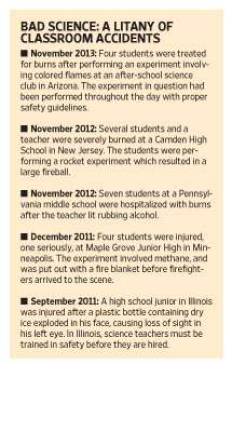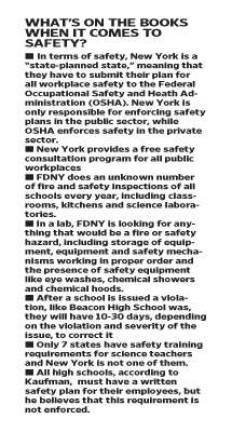School Lab Accident Raises Safety Questions


An experiment at the Beacon School left a student severely burned, focusing attention on oversight in the school labs
Like something out of a teacher (and parent)'s worst nightmare, a chemistry experiment during the first week back after winter recess went horribly wrong at Beacon High School. The accident left two students badly burned, one with life-threatening injuries. The New York Times reports that the teacher, Anna Poole, had been known for her safety consciousness.
Yet, after investigating the accident, the FDNY found eight violations in the lab classroom at the Upper West Side high school, including improper storage of chemicals and flawed safety equipment. The teacher had been performing a so-called "Rainbow" experiment, which mixes methanol with various chemicals to produce colored flames. The exact experiment had been a flagged in a warning video put out by the United States Chemical Safety Board a few weeks before the accident occurred.
All of this make parents and teachers wonder: Could this happen again at their school, and are children safe in their 7th period chemistry class?
"This is why all schools need a good lab safety program that performs inspections of each lab; you don't need an advanced degree in rocket science to see that safety equipment is not working properly," said Jim Kaufman, the director of the Laboratory Safety Institute in Massachusetts. "I've been in classrooms where I've pulled the handle of the shower and no water comes out because the school has turned off the water supply to keep kids from fooling around."
This was the reality for Principal Olga Livanis at the New Explorations into Science, Technology and Math School on the Lower East Side when she first came to the school eight years ago. At that time, she said, she had to call OSHA to get a safety shower and a chemical storage cabinet installed. Dr. Livanis, one of the authors of the citywide school science guidelines handbook, said that one of the main reasons she was aware of these precautions was because of her background in science. Livanis claimed that to her knowledge, her school has not been inspected specifically for laboratory safety.
"This can't be," said Principal Livanis. "Suppose my background was not in science, it's a lot for a principal who's a humanities person and isn't knowledgeable, to make sure all of this is in place. It's unfair to slap a violation on a school after the fact, because accidents do happen. Every high school should be inspected to make sure this does not happen in the first place."
FDNY spokesperson Frank Dwyer stated that all schools are inspected annually as per the fire safety code. When asked if they specifically inspect labs for safety, he said that all parts of the school are inspected, and that a lab classroom would just have different characteristics of inspection (i.e. proper equipment storage). The Department of Education did not respond in time for comment about inspections.
The Laboratory of Safety Institute has found 5,000 school lab accidents, many resulting in serious injuries or even casualties, over the past 30 years. Kaufman said that he was an expert witness in the lawsuit featured in the safety video issued by the U.S. Chemical Safety Board. In 2006, Calais Weber, 15 at the time, had over 40 percent of her body burned after a "Rainbow" experiment gone awry at her high school in Ohio.
At Manhattan/Hunter Science School on the Upper West Side, Principal Kevin Froner said that like Kaufman suggests, his school has a lab specialist, who examines the school laboratories for safety. However, he is unsure if most schools have lab specialists. Froner said that he is also completely unaware of the free safety consultation services offered by the state, as well as the Laboratory Safety Institute.
"No one knows if this was just a freak accident, or a cause of violations, but schools are definitely talking about it," said Principal Froner. "Having someone on our campus devoted to the labs and keeping kids safe makes a huge difference."
Bad Science: a litany of Classroom Accidents
n November 2013: Four students were treated for burns after performing an experiment involving colored flames at an after-school science club in Arizona. The experiment in question had been performed throughout the day with proper safety guidelines.
n November 2012: Several students and a teacher were severely burned at a Camden High School in New Jersey. The students were performing a rocket experiment which resulted in a large fireball.
n November 2012: Seven students at a Pennsylvania middle school were hospitalized with burns after the teacher lit rubbing alcohol.
n December 2011: Four students were injured, one seriously, at Maple Grove Junior High in Minneapolis. The experiment involved methane, and was put out with a fire blanket before firefighters arrived to the scene.
n September 2011: A high school junior in Illinois was injured after a plastic bottle containing dry ice exploded in his face, causing loss of sight in his left eye. In Illinois, science teachers must be trained in safety before they are hired.